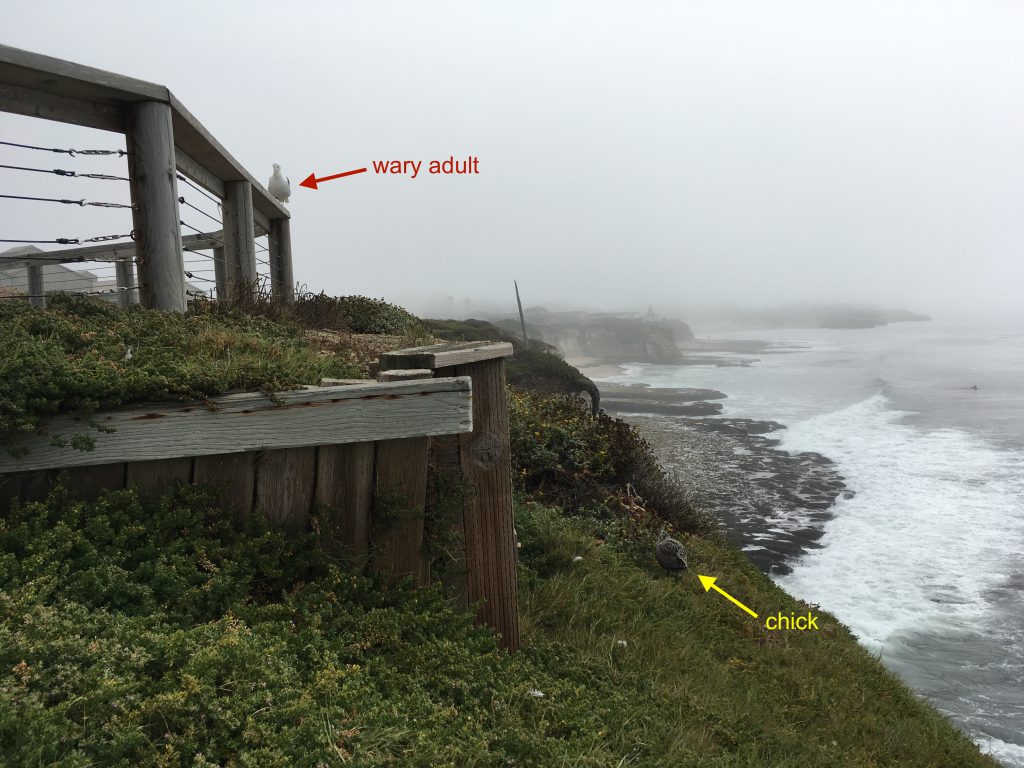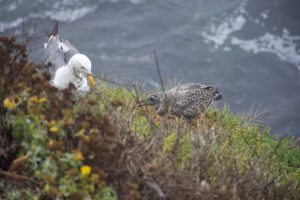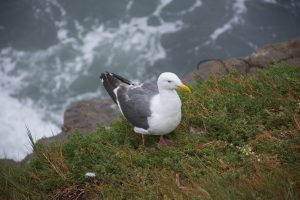Earlier this week I accidentally came upon a baby bird. I was on my way out to the cliff at the marine lab to dispose of a corpse (a fish that died of natural causes) when I noticed a western gull perched on the fence railing and allowing me to get unusually close. It was wary, though, and very alert. When I stopped to listen and watch for a while I heard a high-pitched “cheep-cheep-cheep” coming from beyond the shrubs on the other side of the fence. To get to the point where I could throw the dead fish off the cliff I had to pass closer than I wanted to the chick, which I could then see standing among the ground cover.
The western gull (Larus occidentalis), or WEGU in birders’ parlance, is a California Current endemic species. It is a bird of the Pacific coast of North America, and is rarely found more than a few miles inland. So if you don’t live right on the coast and have problems with gulls in landfills or parks, you cannot pin the blame on a WEGU. Western gulls are present year-round, feeding on whatever they can get. Like many gulls they are quite efficient scavengers and have a varied diet that often includes human refuse. They have become quite adapted to human presence, and have taken advantage of the fact that we tend to leave our garbage all over the place.
Yesterday the chick was in the same area, only a little more visible from directly above. I’d seen as many as five adults hanging around the chick, with no idea who the actual parents are. The chick is big and feathered enough to thermoregulate on its own but is still entirely dependent on its parents (and other cooperative adults) for food.
Being a gull, it is very vocal. It doesn’t sound like a gull, though. The calls sound like they’re coming from a much smaller bird. It cheeped continuously during the 20 minutes or so I was watching it, even with its parents standing right next to it. When this chick fledges, the only direction it can go is out over the water. Unless it can steer its flight well enough to land on one of the intertidal benches to the left of its present location, it’ll end up in the water. I imagine it will be able to swim just fine, but the next thing it will have to learn is how to get up in the air from the water.
Western gulls do not migrate and, garbage notwithstanding, depend on the California Current for most of their food. And while it may seem that there are gulls all over the place with plenty to burn, the WEGU’s restricted range makes this species vulnerable to perturbations in the ecology of the coastal ocean. Not only might their food supply be interrupted as prey species’ distributions change, but their nesting sites on cliffs may be inundated as sea level rises due to climate change.
Gulls have a reputation as trash birds, but the adult WEGU really is beautiful. Their large-ish body size, pure white head and front, and pink legs/feet are pretty distinctive. WEGUs are the only gulls that I feel at all comfortable IDing in the field, and that’s only when the birds are in adult plumage. This species, and many other gull species, takes four years to attain the adult coloration. The juveniles of many species all look very similar, which makes field identification a hazardous exercise. To make things even more complicated, western gulls are known to hybridize with the glaucous-winged gull (Larus glaucescens); fortunately for California birders, the hybridization zone is further north in Washington State.
Seabirds of all types depend on their feathers for insulation. Small-bodied endotherms like birds have an unfavorable surface area:volume ratio and would be unable to maintain their body temperature in cold water if they didn’t have insulation. One of the adaptations that enables a life in cold water is a preen gland near the base of the tail. This gland secretes an oily substance that the bird spreads over its feathers as a waterproof coating, very effectively shielding the body from the cold water. Feathers themselves have water-shedding properties of their own, but augmenting this feature with oil is sheer genius. You’ve heard the phrase “like water off a duck’s back”? We can say that because ducks and other water fowl have preen glands.
Feathers must be clean and lie properly for a bird to fly and thermoregulate, and birds at rest spend a lot of time grooming. All birds preen, but for aquatic birds this activity is especially crucial. Watching a bird preen is like watching a cat take a bath: the sequence of actions appears to be haphazard, but eventually the whole body gets attention.



